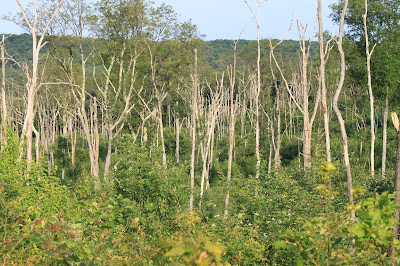This site is huge and I realize now that I'm not sampling half of it. Here's an image from Google Earth (Pro). I sample the site WSW from Wanamie and NE from the same town. The habitats are very different. Field A (the larger field on the left) is mixed grass and shrub) and Field B is just grass.
I did happen to find a coyote scat full of raspberries. Also, there is one large oak in the middle of the site. Last round it was completely denuded by gypsy moth caterpillars. This round much of the growth was back.
 |
| Looks like early spring but this are regrown leaves |
 |
| Gypsy moths completely defoliated this oak |
 |
| Apparently this is Blue Grosbeak habitat in NE PA |
 |
| Coyote scat |
TUESDAY 6/30/2015 @ The office and lab
Rain kept me in for the day. Submitted a grant to study Wood Thrush population dynamics from PA DCNR - the same organization funding the current project. If I do get it, I'll have dozens of cameras to get an index of deer herd size for two years. Then I can look at the interaction between deer herd size and Wood Thrush demography.
Had the high school kids back in the lab today and they were bored but we ran a gel that didn't work. We couldn't even see the ladder. I need more knowledge.
Supposed to rain tomorrow but if I can I'll head out to the Jacob's property. Wettest June in my memory.
WEDNESDAY 7/1/2015
It rained of course.
THURSDAY 7/2/2015 SGL221-Cresco
Love this site though a rough beginning. This site was cut and left to regrow and finding my way (no trail) between point 4 (on a trail) and point 3 (on trail). The trail is horseshoe shaped with 3 and 4 on the points. Blueberries were ripe and completely covered the ground layer. Bird-wise no surprises. Two bluebird families were nice to see WITHOUT birdhouses and there were Veery all over the place. Might have heard Blue Grosbeaks off in the distance but not counting it. After the count went to Jacob's property to work on the trail from the church parking lot to the pipeline.
 |
| Dead trees at Cresco - I wonder if they sprayed the place. Lots of woodpeckers at the site and hosts two families of Eastern Bluebird families. |
 |
| Grassy spot at Cresco. I think this is referred to as a bald. Despite the small size (10 m wide by 25 m long) there are field sparrows that use it. |
 |
| View from point 3 (a large bolder) - point 4 is down slope from this point |
 |
| Common Yellowthroat |
I wear wellies - green boots that nearly reach my knee - when doing point counts. I think it saves me from ticks and chiggers and getting my feet soaked. But when the grass is waist high the boots don't do much for your legs and waist. I got soaked and it was in the low 60's that morning and I didn't get warm until I hot shower. However, it was a beautiful morning there. I'm still not sure why there aren't Grasshopper Sparrows there. Is it a dispersal issue? Some subtle habitat component that's missing? Area of the grassland? Dunno. Hopefully, the vegetation analysis that we do later will uncover something.
The 60 cube ice trays came in and so did a cooking thermometer. Hopefully by paying more attention to detail (in this case the temperature of the fructose syrup and gelatin) we can produce more fruit like candies. I also have three pounds of bees wax coming in to coat them. This should be interesting.
SATURDAY 7/4/2015
Hopefully get some good writing in today. The urbanization paper deadline is 7/31.
SUNDAY 7/5/2015 Lackawanna State Park and Campbell's Ledge
Lackawanna State Park was slow as all the sites are. There were though, Bobolinks at both sites (the kid-fishing pond and the aviation field). They're not there earlier so I'm supposing this are post breeding adults. Interesting. Very interesting.
Usually I would have great pictures from Campbell's Ledge - the fog was incredible dense - creepily so. The garbage from fireworks was a bit depressing but not surprising. Two Indigo Bunting were calling and not much else. Even field sparrows are slowing down.
 |
| Female (or imm.?) Bobolink at Lackawanna State Park |


No comments:
Post a Comment